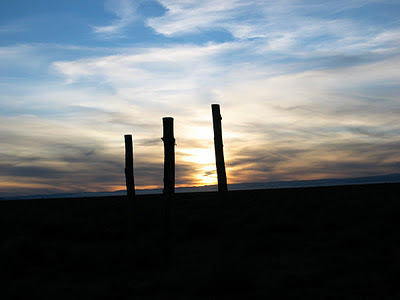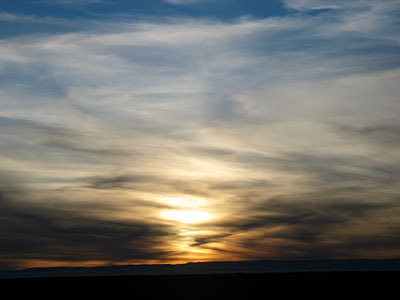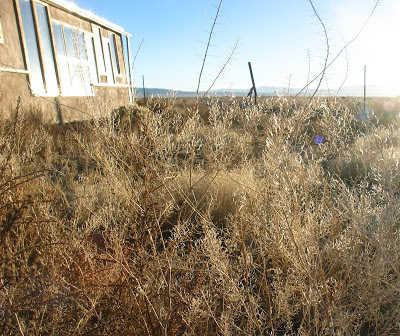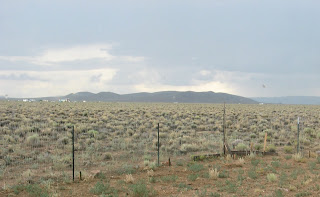The blue snow shadows calm my mind a little.
Why This Project
Tuesday, December 18, 2012
Snow Brooms
The blue snow shadows calm my mind a little.
Friday, December 14, 2012
Tuesday, December 11, 2012
Hard Frost
Tuesday, November 6, 2012
Shadows Roll In
Wednesday, October 24, 2012
Tuesday, October 16, 2012
Gravel
This pile of gravel is our latest Sisyphean project; we have to sift through it to remove the dirt. I like big, apparently insurmountable projects like this. I spent over an hour shoveling and sifting today, burying my fingers in the damp soil as I spread the stones across the sieve that Eric made. He constructed the sieve by nailing a piece of mesh to an antique window frame. We sift the dirt out into the wheelbarrow, then haul the soil over to a ridge we're creating to defend our struggling flowerbed against rabbits. The gravel will fill the trenches that will form the foundation of the strawbale addition to the house. The addition is intended to be a mudroom, but it will also provide extra insulation against the winter wind.
I can't believe winter is on the way already. The sooner we fill up the trenches and finish the addition, the warmer we'll be when the winter winds start in earnest.
Wednesday, October 10, 2012
Sunday, October 7, 2012
Friday, October 5, 2012
Wednesday, October 3, 2012
Empty House
Thursday, September 27, 2012
Saturday, September 22, 2012
Thursday, September 20, 2012
Dirt Road
Tuesday, September 18, 2012
Rosh Hashanah
Sunday, September 16, 2012
Dawn Light
This view of Blanca at dawn reminds me of one of my favorite Mary TallMountain poems.
Bright Shining
Companion to me in every place,
You stretch your hand: I see
Majesties of mountains
Crowned with living light.
Your arm flings wide: I see
Wild little islands wrapt in fog
Grey luminous; hidden folds
Of emerald and ermine earth.
I fly free clean through glowing
Cat's eye aquamarine
Filled with light air breath
Swaddled in this cocoon
This dense and lifeless mass
Yet weightless I
soaring with it shall be for you
Light bright shining
by Mary TallMountain
The Light on the Tent Wall
Los Angeles: University of California, 1990
Saturday, September 15, 2012
August Shadows
I haven't written any new haiku since August. I guess I've been in a survival mode, trying to finish my reflexology program while scraping together enough income to keep things going. But I also believe that poetry and photography are also necessary for survival; maybe that's why I've had such a deep sense of fatigue lately. I want to be able to stop worrying about money, bills, taxes, etc., but I also need to start writing poems and stories again, and taking walks with my camera the way I used to.
Thursday, July 5, 2012
Tuesday, July 3, 2012
Rain Offering
Saturday, April 7, 2012
Hoofprints
 We walked up to the Dome recently to see the new green lichen growing on the rocks. There may be pooled water or even a small spring under the rocks; the Dome attracts a lot of wildlife. The earth around the Dome had been marked by dozens of hooves in various sizes.
We walked up to the Dome recently to see the new green lichen growing on the rocks. There may be pooled water or even a small spring under the rocks; the Dome attracts a lot of wildlife. The earth around the Dome had been marked by dozens of hooves in various sizes.
Wednesday, April 4, 2012
Monday, April 2, 2012
Blanca Meets Alma
 Eric hand-painted this sign to mark one of the roads on the way to our house. The sign had been missing for months, and we were worried that our friends would get lost trying to find our place. We have very few visitors, so we try to make it as easy as possible for those who venture out here to find us.
Eric hand-painted this sign to mark one of the roads on the way to our house. The sign had been missing for months, and we were worried that our friends would get lost trying to find our place. We have very few visitors, so we try to make it as easy as possible for those who venture out here to find us. A Place in the World
When the world outside meets the world inside,
the ragged edges of a torn self
find each other, settle in,
and form a seam.
And you learn that gravity is not a force
that keeps your body on the earth
when you most want to leave,
but something more like grace,
guiding you to a place
you never left.
Saturday, March 10, 2012
Sunday, February 26, 2012
Bone Mask

Wednesday, February 22, 2012
Sand Dunes

 We went for a hike at Sand Dunes National Park a couple of weeks ago. It was a Monday morning, and the admissions booth was deserted. A note taped to the window said that admission was free that day.
We went for a hike at Sand Dunes National Park a couple of weeks ago. It was a Monday morning, and the admissions booth was deserted. A note taped to the window said that admission was free that day.
Monday, February 20, 2012
Morning Smoke

Thursday, February 16, 2012
Friday, February 10, 2012
Widows


Tuesday, February 7, 2012
Between Mesas

Clear twilight
fills the bowl
between two mesas,
a cup of water
for the weary heart.

I love the mesas in winter; the snow highlights their hollows and planes, revealing the crevices that aren't visible in the warmer months. I spent over an hour trying to find a phrase to describe the way the sky fills the space between these ancient formations, how the parabola between them seems to offer itself like an open bowl. A woman I know once said that God is space, and having lived out here for awhile, I believe she was right.
Friday, February 3, 2012
Two Birds
Monday, January 30, 2012
Iron Grass

These gray grasses, toughened by sun and drought, embody what I love about this micro-environment. The metallic blades of these grass tufts will never see green again, but they'll be here for years, simply enduring. I love the colorless, indestructible presence of these plants, which are no longer living but are nevertheless still here. They are survivors of prolonged thirst and parched air, and like many survivors, there's a profound stillness about them. I imagine that even the harsh wind slows down to touch them gently.
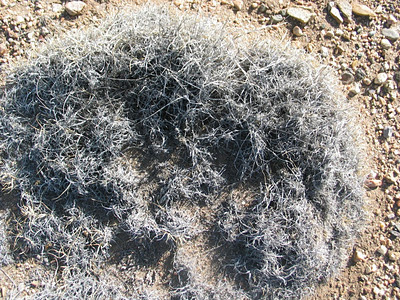
Saturday, January 28, 2012
Thursday, January 26, 2012
Lunar Maria

The inception of the Rio Grande Rift in northern New Mexico and southern Colorado was accompanied by voluminous mafic volcanism preserved in part as erosional remnants on an intrarift horst within the current axial rift graben of the San Luis Valley.Journal of Geophysical Research, vol. 96, no. B8: "Oligocene Basaltic Volcanism of the Northern Rio Grande Rift: San Luis Hills Colorado"; R.A. Thompson, C.M. Johnson and H.H. Mehnert; 1991.
The basalt hills behind our house are ancient shapes, the soft aftermath of ancient volcanic activity. In the evening the hills seem to embody the earth's memory, gently sloping into darkness.
Basalt is an igneous rock, porous yet dense, the color of charcoal. The lunar maria are the basalt plains of the moon. Once believed to be seas, the mare basalts are actually vast, dark plains created by volcanic explosions.
Monday, January 23, 2012
Beach Combing in Winter

Thursday, January 19, 2012
Monday, January 16, 2012
The Visitors
 This land appeared to be uninhabited until the owners temporarily took over in the summer. Like everyone who visits the Valley for the first time, or who innocently attempts to set up house here, they weren't ready for the wind. They set up a tent for their fishing gear and cooking equipment -- the wind blew it down. They installed a plastic shed to store their things -- the wind ripped it apart. So now our visitors have given up, it seems, and have left their belongings to the vagaries of the wind.
This land appeared to be uninhabited until the owners temporarily took over in the summer. Like everyone who visits the Valley for the first time, or who innocently attempts to set up house here, they weren't ready for the wind. They set up a tent for their fishing gear and cooking equipment -- the wind blew it down. They installed a plastic shed to store their things -- the wind ripped it apart. So now our visitors have given up, it seems, and have left their belongings to the vagaries of the wind. Friday, January 13, 2012
Wednesday, January 11, 2012
Three Sisters
